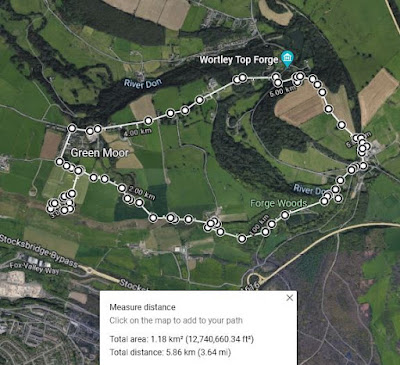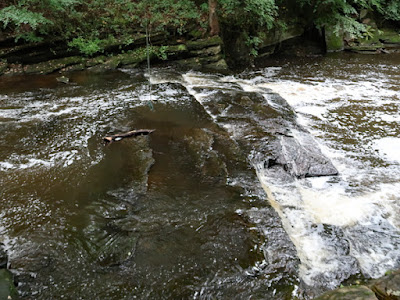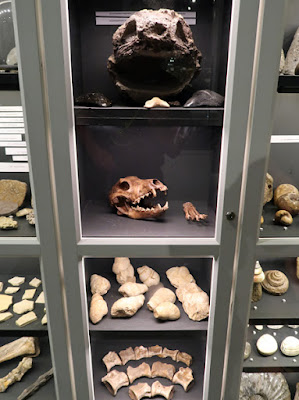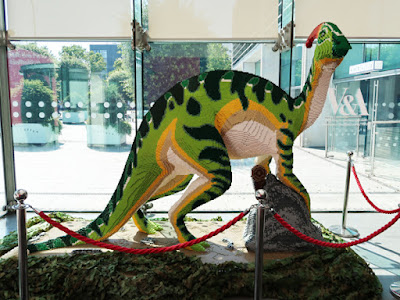With no opportunities to explore any quarry exposures at Bell Hagg and Crosspool, it had only taken just over an hour to walk from Redmires Road down to Roscoe Bridge, an early C19 road bridge spanning the River Rivelin that I wanted to photograph for the British Listed Buildings website Photo Challenge.
I went to have a quick look at various remains of the Roscoe Wheel (1725), which include the stone built wheel-pit and arch. The mill was mainly used for the fender and saw grinding trade, for which huge grindstones exceeding 2 metres in diameter were required, but it was derelict by 1936 and the various buildings, including cottages, have long since disappeared.
A little further downstream, I passed the Rivelin Chair sculpture by Jason Thomson, but on this occasion I was more interested in the outcrop of Crawshaw Sandstone forms a small cliff on the north side of the river, which appears to have been excavated for some reason but now has a sturdy iron grill covering the entrance.
The section here comprises mainly thin bedded, rather flaggy sandstone with some slightly thicker massive beds but there are no obvious physical characteristics that make it stand out against the other Pennine Coal Measures Group sandstones in the region.
Continuing past Rivelin Park Cafe, I returned to the river bank to take a look at the weir that formed part of Hollins Bridge Mill (1724), which was originally used for grinding cutlery but, at a later date, it ground optical lenses for use in telescopes and glasses, with it subsequently being converted into a corn mill in 1868.
Following the path on the west side of the river, I took a diversion down to the river bank at Hollins Bridge. Although I don’t know its purpose, there are the remains of part of a wall that runs along the streambed a couple of metres out from the west bank.
Crossing Hollins Lane and continuing along the path a few metres above the level of the river, just before the path dropped down to the stepping stones, I noticed a small outcrop of what I later discovered is the Middle Band Rock.
Although I had passed over this formation when exploring the historic architecture of Stannington, I did not have this in my rock collection. The samples that I took with my Estwing hammer are a light brown/grey very fine grained sandstone, with carbonaceous inclusions and occasional specks of muscovite mica.
The path then drops down to a meander in the river, which has eroded the strata on its west bank to form a small cliff. Large squared blocks of stone form a path down to the river, which continue as stepping stones, with a ramp for vehicles next to it.
Crossing the stepping stones, I took a few record photographs of the rock exposure, which consists of a section of Middle Band Rock that is underlain by darker Pennine Lower Coal Measures Formation mudstones, with the latter having been eroded by the river to leave a overhang.
I had a quick wander around Walkley Bank Tilt (c.1751), which was originally a cutlers’ wheel but was converted into a tilt forge and later a wire-drawing mill. The dam still exists, but all of the buildings have long since disappeared, with just a small bridge and stone built infrastructure of unknown purpose remaining.
Making my way further downstream, I could only catch glimpses of the buildings at Mousehole Forge, which dates back to at least 1628. The forge is now a private property and I could only see parts of it through the main gates and over boundary walls.
I finished my walk along the Rivelin Valley by having a quick look at the weir at Grogram Wheel and was surprised to to see that the banks and the island in the river downstream are made up of iron slag, which was tipped into the river by the occupants of the Mousehole Forge.
The iron slag is in part very dense and rust coloured, but it also has blackened parts that are full of air bubbles and look like crozzle, which I had seen used to top boundary walls at various place in Sheffield. The slag is surprisingly hard and, with no obvious projections from its surface, it was not that easy to break off a sample with my hammer.
Arriving at Malin Bridge, I took advantage of the Lidl supermarket to do some essential shopping, before taking a few photographs of the sculpture by Steve Roche, which depicts some of the items that were included in insurance claims after the Great Sheffield Flood in 1864.



















































